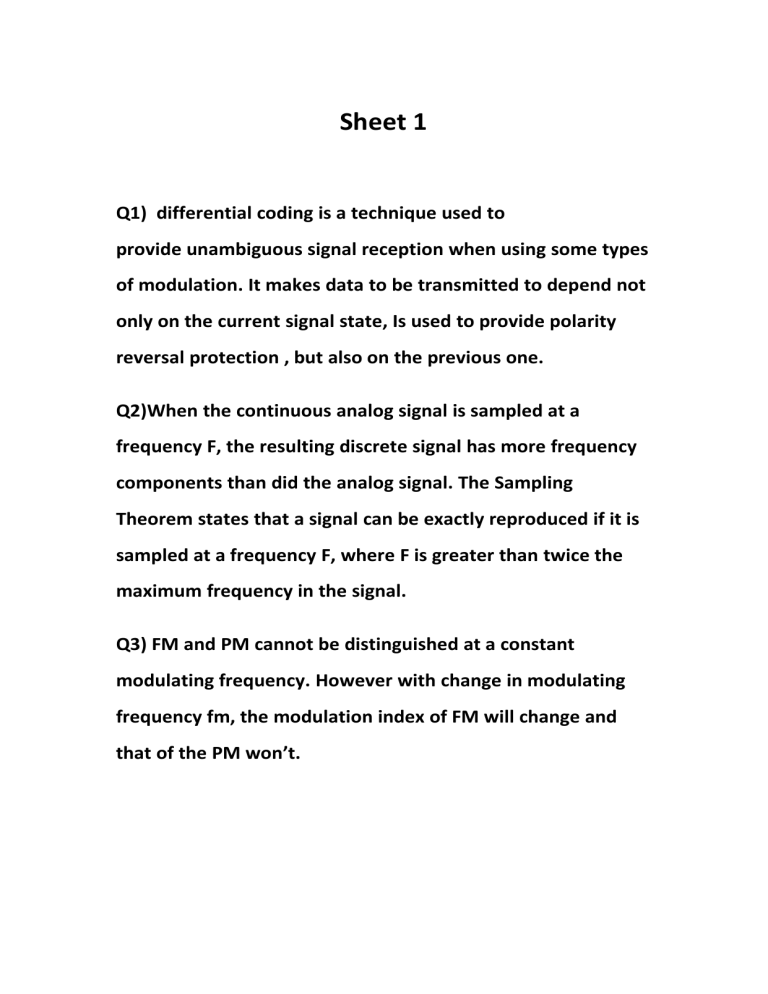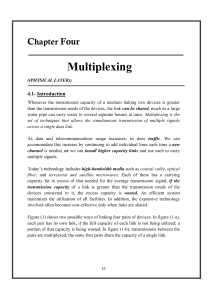
Sheet 1 Q1) differential coding is a technique used to provide unambiguous signal reception when using some types of modulation. It makes data to be transmitted to depend not only on the current signal state, Is used to provide polarity reversal protection , but also on the previous one. Q2)When the continuous analog signal is sampled at a frequency F, the resulting discrete signal has more frequency components than did the analog signal. The Sampling Theorem states that a signal can be exactly reproduced if it is sampled at a frequency F, where F is greater than twice the maximum frequency in the signal. Q3) FM and PM cannot be distinguished at a constant modulating frequency. However with change in modulating frequency fm, the modulation index of FM will change and that of the PM won’t. Q4) Analog signals representing digital data would typically have sudden changes in the signal values; this essentially means that the frequency spectrum of the underlying signal is wide. PCM is better at encoding such signals since it attempts to approximate the actual signal value and can handle large variations in short time (high frequency components). On the other hand, Delta Modulation encodes the difference to within some level of precision, and would have high overload/underload effects when signal values have large sudden variations. Q5) In telecommunications, asynchronous communication is transmission of data, generally without the use of an external clock signal, where data can be transmitted intermittently rather than in a steady stream. Any timing required to recover data from the communication symbols is encoded within the symbols. In Asynchronous. Q6) Interference is avoided under frequency division multiplexing by the use of guard bands, which are unused portions of the frequency spectrum between subchannels. Q7) Interference is avoided under frequency division multiplexing by the use of guard bands, which are unused portions of the frequency spectrum between subchannels. Q8) A statistical Time Devision Multiplexing is more efficient than a synchronous TDM because it allocates time slots dynamically on demands and doesm't dedicate channel capacity to inactive low speed lines. Q9) In synchronous TDM, every device which is present in this has given the same time slot to transmit data. It does not consider whether the device contains data or not. The devices place their data on the link when their time slots arrive, if somehow any device does not contain data its time-slot remains empty. There are various kinds of time slots that are organized into frames and each frame consist of one or more time slots dedicated to each sending device. Q10) (SNR)db=6.02n+1.76, where n is the number of bits used for quantization. In this case, (SNR)db=60.2+1.76 =61.96 dB Q11) a. (SNR)db = 6.02 n + 1.76 = 30 dB n = (30 – 1.76)/6.02 = 4.69 Rounded off, n = 5 bits This yields 25 = 32 quantization levels b. R = 7000 samples/s × 5 bits/sample = 35 Kbps Q14) Q15) A)Total overhead; 2 x 10,000 = 20,000 bits. Time overhead; 20,000/2400 = 8.3333 seconds. B)10,000 characters/1000 per frame=10 frames required to transmit file. Overhead in bits is 10 x 48 = 480 bits. Time overhead is 480/2400 =0.2 seconds. Q16) synchronous TDM: 100 x 9600 bps = 960,000 bps statistical TDM: 100 x 9600 bps x 0.5/0.8 = 600,000 bps Q17) Assuming 4 k Hz per voice signal, the required bandwidth for FDM is 24 × 4 = 96 kHz. With PCM, each voice signal requires a data rate of 64 kbps, for a total data rate of 24 × 64 = 1.536 Mbps. At 1 bps/Hz, this requires a bandwidth of 1.536 Mhz Q18) A synchronous time division multiplexer interleaves bits from each signal and takes turns transmitting bits from each of the signals in a round



